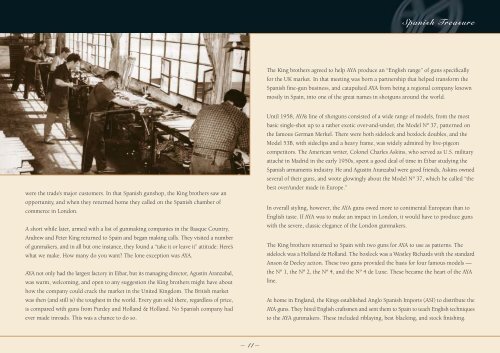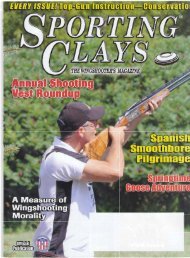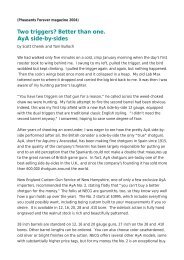. Cat.logo_AYA(1-15).fh8 - AYA, Aguirre y Aranzabal
. Cat.logo_AYA(1-15).fh8 - AYA, Aguirre y Aranzabal
. Cat.logo_AYA(1-15).fh8 - AYA, Aguirre y Aranzabal
Create successful ePaper yourself
Turn your PDF publications into a flip-book with our unique Google optimized e-Paper software.
were the trade’s major customers. In that Spanish gunshop, the King brothers saw an<br />
opportunity, and when they returned home they called on the Spanish chamber of<br />
commerce in London.<br />
A short while later, armed with a list of gunmaking companies in the Basque Country,<br />
Andrew and Peter King returned to Spain and began making calls. They visited a number<br />
of gunmakers, and in all but one instance, they found a “take it or leave it” attitude: Here’s<br />
what we make. How many do you want? The lone exception was <strong>AYA</strong>.<br />
<strong>AYA</strong> not only had the largest factory in Eibar, but its managing director, Agustín <strong>Aranzabal</strong>,<br />
was warm, welcoming, and open to any suggestion the King brothers might have about<br />
how the company could crack the market in the United Kingdom. The British market<br />
was then (and still is) the toughest in the world. Every gun sold there, regardless of price,<br />
is compared with guns from Purdey and Holland & Holland. No Spanish company had<br />
ever made inroads. This was a chance to do so.<br />
– 11 –<br />
Spanish Treasure<br />
The King brothers agreed to help <strong>AYA</strong> produce an “English range” of guns specifically<br />
for the UK market. In that meeting was born a partnership that helped transform the<br />
Spanish fine-gun business, and catapulted <strong>AYA</strong> from being a regional company known<br />
mostly in Spain, into one of the great names in shotguns around the world.<br />
Until 1958, <strong>AYA</strong>’s line of shotguns consisted of a wide range of models, from the most<br />
basic single-shot up to a rather exotic over-and-under, the Model Nº 37, patterned on<br />
the famous German Merkel. There were both sidelock and boxlock doubles, and the<br />
Model 53B, with sideclips and a heavy frame, was widely admired by live-pigeon<br />
competitors. The American writer, Colonel Charles Askins, who served as U.S. military<br />
attaché in Madrid in the early 1950s, spent a good deal of time in Eibar studying the<br />
Spanish armaments industry. He and Agustín <strong>Aranzabal</strong> were good friends, Askins owned<br />
several of their guns, and wrote glowingly about the Model Nº 37, which he called “the<br />
best over/under made in Europe.”<br />
In overall styling, however, the <strong>AYA</strong> guns owed more to continental European than to<br />
English taste. If <strong>AYA</strong> was to make an impact in London, it would have to produce guns<br />
with the severe, classic elegance of the London gunmakers.<br />
The King brothers returned to Spain with two guns for <strong>AYA</strong> to use as patterns. The<br />
sidelock was a Holland & Holland. The boxlock was a Westley Richards with the standard<br />
Anson & Deeley action. These two guns provided the basis for four famous models —<br />
the Nº 1, the Nº 2, the Nº 4, and the Nº 4 de Luxe. These became the heart of the <strong>AYA</strong><br />
line.<br />
At home in England, the Kings established Anglo Spanish Imports (ASI) to distribute the<br />
<strong>AYA</strong> guns. They hired English craftsmen and sent them to Spain to teach English techniques<br />
to the <strong>AYA</strong> gunmakers. These included riblaying, best blacking, and stock finishing.




